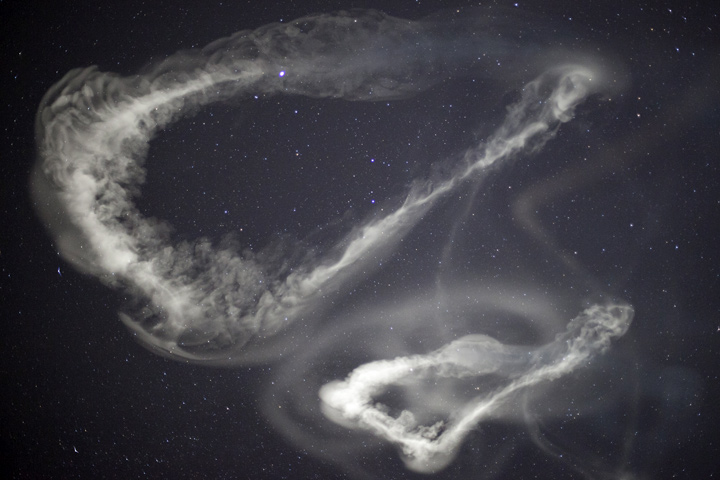



Five sounding rockets streaked into the pre-dawn sky on March 27, 2012, leaving trails of milky white clouds in a little understood part of the atmosphere. The first rocket was launched to the cusp of space at 4:58 a.m. Eastern Daylight Time, and the subsequent launches occurred at 80 second intervals. The goal of the Anomalous Transport Rocket Experiment (ATREX) was to improve understanding of the process that drives fast-moving winds high in the thermosphere.
Fiery trails from four of the five sounding rockets are clearly visible in this time-lapse photograph (top) of the launch. The second image shows two of the clouds left in the wake of the experiment; the rockets released trimethyl aluminum, a substance that burns spontaneously in the presence of oxygen. The harmless by-products of this glowing reaction were visible to the naked eye as far south as Wilmington, North Carolina; west to Charlestown, West Virginia.; and north to Buffalo, New York. Both photographs were taken near the launch site at NASA’s Wallops Flight Facility in Virginia.
Throughout the experiment, researchers used specialized cameras in North Carolina, Virginia, and New Jersey—as well as temperature and pressure instruments on two of the rockets—to monitor the clouds. By measuring how quickly the clouds move away from each other and integrating that information into atmospheric models, they hope to improve their understanding of the 320 to 480 kilometer (200 to 300 mile) winds in the thermosphere.
First noticed by scientists in the 1960s, the winds are thought to be part of a high-altitude jet stream that’s distinct from the one lower in the troposphere, where commercial aircraft fly. Observing the turbulence produced by these winds should make it possible to determine what’s driving them.
An improved understanding of the upper jet stream will make it easier to model the electromagnetic regions of space that can damage satellites and disrupt communications systems. The experiment will also help explain how the effects of atmospheric disturbances in one part of the globe can be transported to other parts of the globe in a mere day or two.
The launches are part of a broader sounding rocket program at NASA that conducts approximately 20 flights a year from launch sites around the world.
Photographs by Brea Reeves and Chris Perry from NASA's Wallops Flight Facility. Caption by Adam Voiland and Karen Fox.